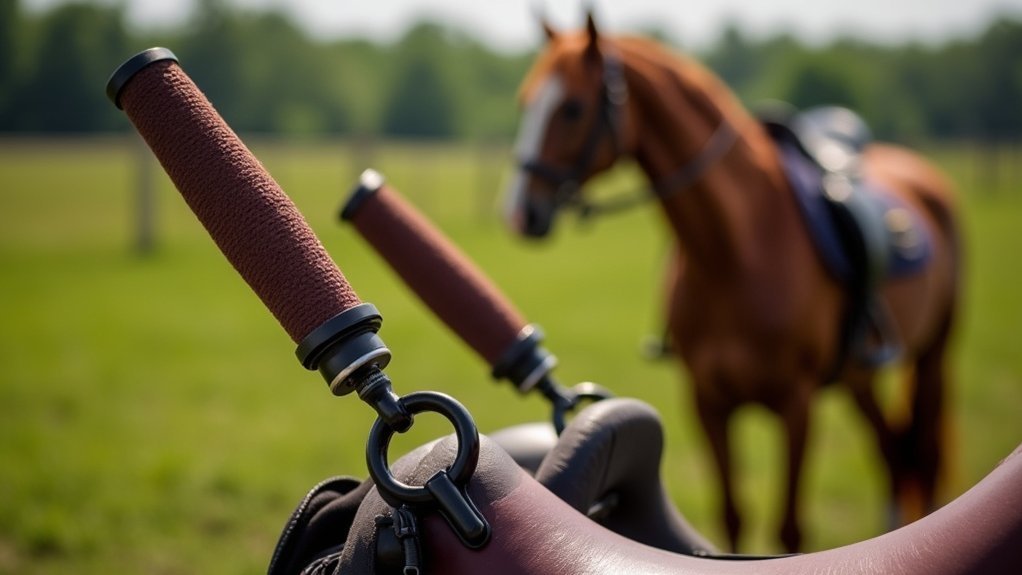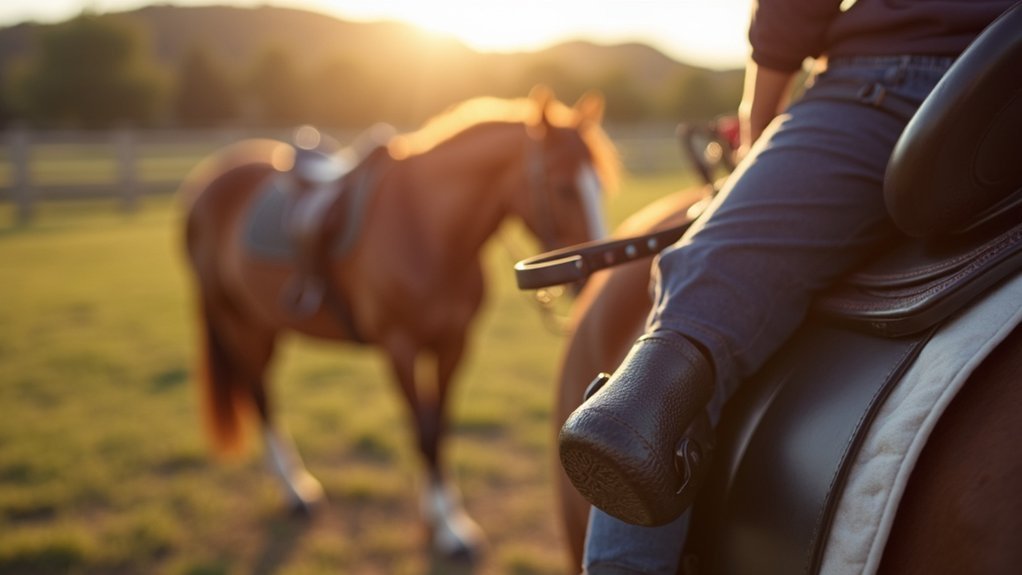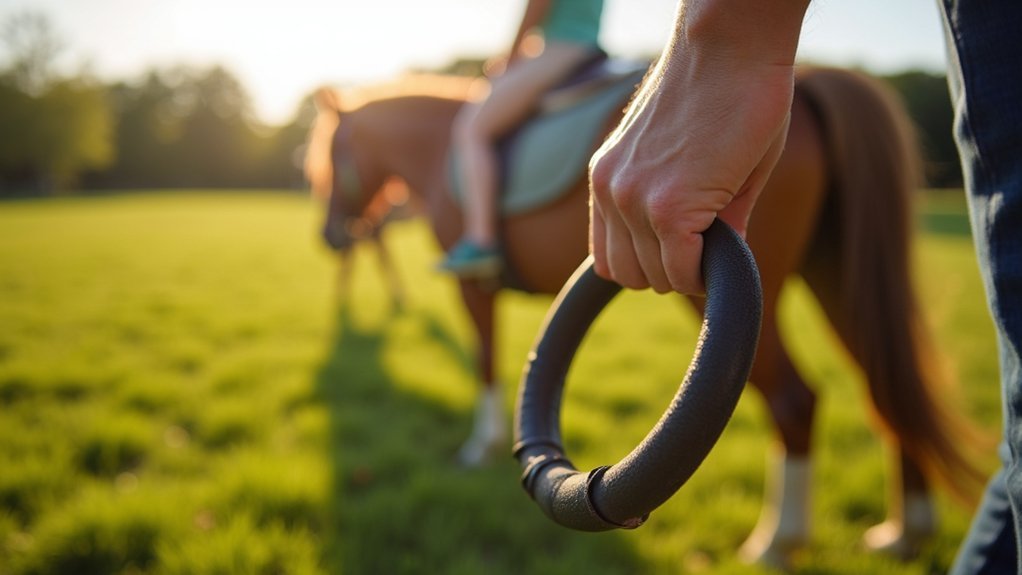Therapeutic riding handles provide essential stability and support for riders of all abilities. You’ll find various options including high-back saddles, bareback pads with grip points, and specialized GLAD Belt technology. These tools enhance safety while engaging core muscles, improving posture, and building confidence. When using handles, maintain a secure yet relaxed grip with elbows bent close to your body. Proper handle use creates a foundation for balance skills that transfer to daily activities beyond the saddle.
Therapeutic Horse Riding Handles: Safety & Balance

When starting therapeutic horseback riding, safety and balance often present the biggest initial challenges for riders of all abilities. Specialized riding handles serve as essential adaptive equipment, providing the stability and support you need during your sessions.
These handles are designed for easy gripping, allowing you to maintain balance and coordination while learning to self-correct your position. You’ll find that having something secure to hold greatly boosts your confidence, freeing you to focus on developing your riding skills rather than worrying about falling.
Your instructor will use these handles strategically during exercises to help engage your core muscles and improve your overall stability.
With proper handle support, you’ll experience therapeutic horseback riding as both safer and more enjoyable, regardless of your physical abilities.
The Essential Role of Handles in Therapeutic Riding
Although many equestrian accessories enhance the riding experience, therapeutic riding handles play a uniquely essential role in making horseback therapy accessible to riders with various abilities. These handles provide you with a secure grip that considerably improves your balance and stability while mounted, reducing fall risks and building your confidence.
You’ll find these handles strategically positioned for easy access, allowing you to make independent adjustments during your ride. As an adaptive tool, they free your attention to focus on developing riding skills rather than worrying about stability.
Your instructor will encourage you to use the handles to engage core muscles while maintaining proper posture. This supportive equipment guarantees you can participate fully in therapeutic riding sessions, regardless of coordination or balance challenges.
Types of Therapeutic Riding Handles and Their Functions

Various therapeutic riding handles exist to meet your specific needs and abilities during equine therapy sessions. These specialized grips help you maintain balance and safety while developing confidence on horseback.
| Handle Type | Function | Rider Benefit |
|---|---|---|
| High-back Saddles | Provides full back support | Ideal for riders needing trunk stability |
| Bareback Pads | Offers multiple grip points | Enhances communication with the horse |
| Saddles with Grips | Strategically positioned handles | Promotes self-correction of posture |
You’ll find these handles positioned for easy access, allowing you to stabilize yourself while still engaging with your horse. Your instructor will train you to use these handles effectively, gradually decreasing reliance as your balance improves. The right handle type can dramatically enhance your therapeutic riding experience by creating a secure environment for skill development.
Proper Hand Positioning for Maximum Stability
Three critical elements define proper hand positioning on therapeutic riding handles, beginning with your grip technique. You’ll want to hold the handles securely but without tension—a death grip creates rigidity that actually diminishes your stability.
Position your hands slightly wider than shoulder-width apart, which provides better leverage during turns and directional changes.
Keep your elbows bent and close to your body while maintaining proper hand positioning on the therapeutic riding handles. This posture optimizes weight distribution and prepares you for unexpected movements from your horse.
As you ride, practice adapting your grip dynamically in response to different gaits. This self-correction ability markedly enhances your balance and overall riding experience.
The right hand position transforms therapeutic riding from a passive activity into an engaging exercise in controlled stability.
How Handles Support Balance Development in Riders

Therapeutic riding handles serve as more than just safety anchors—they’re active tools in a rider’s balance development journey.
With a secure grip, you’ll experience enhanced stability and confidence while your body learns the subtle adjustments needed for proper horseback balance.
The handles provide essential support that allows you to focus on engaging your core muscles and self-correcting your position without fear of falling. You’ll find yourself able to practice independent riding skills while maintaining safety during turns and changes.
As your coordination improves, you can use the handles to stabilize yourself only when necessary, gradually building your balance capabilities.
This security encourages you to experiment with different positions and movements, creating a stronger connection with your body mechanics and steadily advancing your riding skills.
Safety Protocols When Using Therapeutic Riding Handles
Before mounting your horse, guarantee all riding handles undergo a thorough safety inspection to prevent accidents during your session.
Check for signs of wear, tear, or loosening that could compromise their stability and support functions.
Your side walkers should position themselves strategically to assist you while still encouraging independent balance development.
They’ll monitor your grip on the handles and provide verbal cues when necessary.
Establish clear communication skills with your instructor regarding how comfortable you feel using the handles.
If you’re experiencing discomfort or difficulty reaching them, don’t hesitate to speak up—proper handle positioning is essential for your safety.
Selecting the Right Handle System for Different Disabilities
Finding the perfect handle system for your therapeutic riding needs depends largely on your specific disability and personal capabilities.
Consider how well you can grip and stabilize yourself while mounted—this will determine which handle design offers the best support.
Different handle systems feature multiple grips or adjustable heights to accommodate varying strength and coordination levels. Your handle should be positioned to help you maintain balance and control during movement, allowing the horse’s gait to enhance your trunk stability and posture.
A therapeutic handle system should complement your abilities, creating stability that harnesses the horse’s movement to improve your core strength and alignment.
Don’t overlook psychological comfort—a secure grip boosts confidence and encourages active participation.
Before making a final decision, consult with a certified therapeutic riding instructor who can recommend a handle system that prioritizes your safety and comfort while maximizing therapeutic benefits.
GLAD Belt Technology for Enhanced Rider Support
Among the most innovative handle systems in therapeutic riding, the GLAD Belt technology stands out for its exceptional rider support capabilities.
With its three strategically placed handles, you’ll gain enhanced control and balance during therapeutic riding sessions, allowing riders to build confidence while ensuring safety.
The GLAD Belt accommodates riders of all sizes with adjustable waist measurements from 14 to 34 inches, providing:
- Customized support that enables instructors and side walkers to maintain better control
- Improved balance opportunities while reducing fall risks
- Enhanced rider independence as they focus on developing coordination skills
This specialized support system allows you to tailor the therapeutic riding experience to meet individual needs, making the GLAD Belt an essential tool for maximizing safety and effectiveness during equine therapy sessions.
Training Riders to Transition From Handles to Independent Riding
As riders develop confidence and skills through therapeutic riding, moving from supportive handles to independent riding becomes an essential milestone in their equine therapy journey.
To facilitate this shift, focus on exercises that build core strength and balance. Encourage riders to practice stops and turns, which helps them learn to control their center of gravity without handle support.
Create safe opportunities for riders to experience being slightly off-balance, allowing them to develop self-correction techniques. Supportive side walkers should remain present but intervene only after riders attempt corrections themselves.
This approach reinforces independent balance skills while maintaining safety. Remember to provide consistent feedback during training sessions – your encouragement greatly boosts rider confidence as they master independent riding techniques.
Instructor Techniques for Supporting Riders Using Handles
Effective instructors balance physical assistance with opportunities for rider growth when supporting therapeutic riders using handles.
The art of instruction lies in knowing when to support and when to step back, allowing therapeutic riders to discover their own balance.
You’ll want to encourage riders to use handles for stability initially, while gradually promoting self-correction to develop their balance skills. When you notice a rider struggling, resist the urge to immediately assist—instead, give them time to make their own adjustments before offering help.
- Create specific exercises involving handles, such as practicing stops after turns, to help riders center themselves.
- Maintain a supportive environment where riders feel secure using handles as needed.
- Observe riders’ center of gravity during shifts, offering guidance on handle use only when necessary.
This approach builds confidence while developing the independent balance skills riders need for progression.
Physical Benefits of Handle-Assisted Therapeutic Riding
While riders gain confidence through instructor guidance, the physical benefits of handle-assisted therapeutic riding extend far beyond mere stability.
You’ll notice improved stability and balance as handles provide secure contact points, especially valuable if you face coordination challenges.
When you grip the handles, you’re actively engaging your core muscles, which enhances trunk stabilization and improves your posture during sessions.
This engagement transfers to daily activities, as the balance skills you develop on horseback become part of your natural movement patterns.
The handles allow you to participate in targeted exercises that specifically address your individual needs within a supportive therapeutic environment.
You’ll likely find yourself progressing more quickly, as the security of handles reduces fear and lets you focus on the physical benefits of each movement.
Frequently Asked Questions
What Is the 20% Rule in Horse Riding?
The 20% rule means you’re focusing 20% on your balance while letting the horse carry most of your weight. You’ll engage your core, self-correct your position, and develop independent balance, creating harmony between you and your horse.
What Are 3 Safety Procedures the Horse Handler Should Follow When Working Around Horses?
When working around horses, you should approach from the front/side to avoid startling them, use proper halter and lead rope control, and stay away from their hindquarters to prevent kicks. Always observe their body language.
How to Improve Your Balance for Horse Riding?
Strengthen your core and hips during shifts. Practice on circles and turns to adjust your position constantly. Try riding over poles for balance challenges. Experience controlled imbalance to develop self-correction skills. You’ll gain confidence quickly.
Is Therapeutic Horseback Riding Covered by Insurance?
Coverage for therapeutic horseback riding depends on your insurance provider. You’ll have better luck if licensed therapists conduct your sessions. Check your plan details and consider using HSA/FSA funds as alternatives.
In Summary
When you choose the right therapeutic riding handles, you’re empowering riders with both confidence and safety. Whether you’re using a GLAD belt, surcingle grips, or saddle handles, you’ll notice improvements in your riders’ balance, core strength, and independence. Remember, handles aren’t just safety features—they’re stepping stones toward independent riding. With proper training and patience, you’ll help your riders progress toward their therapeutic goals.





Leave a Reply